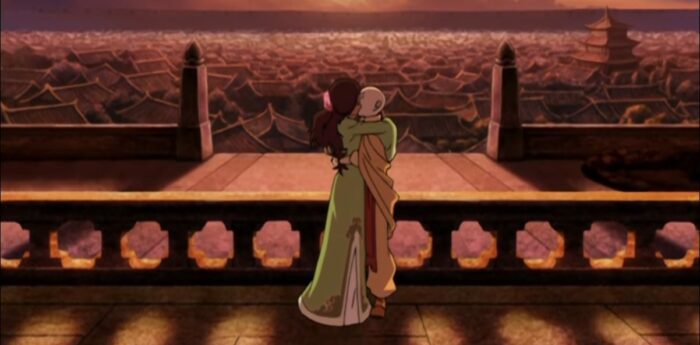“Sozin’s Comet,” the four-part series finale of Avatar: The Last Airbender (ATLA) is that rarest of phenomena; it is a nearly perfect ending for an all-time classic television show. ATLA is one of those shows that has always been in the background, beloved by those who had found it and unknown or dismissed as “kid stuff” by everyone else. Debuting in the 2000s on Nickelodeon, it was never in my demographic wheelhouse.
Even while I was becoming obsessed with other “youth-oriented” properties over the last two decades, it had never become a part of my life. I thought for a long while that it was an anime show, which I respect but have never watched. Then I’d see Toph or Zuko in memes or cosplays and think that they looked pretty interesting, but not for me. The failure of the “movie that must not be named,” which I only knew from lists of the worst films of all time, didn’t help either. But that all changed, both for me and for a large segment of the population, during the COVID-19 pandemic.
In May 2020, Avatar: The Last Airbender was added to Netflix and quickly became something of a phenomenon. People were stuck at home and this little show became the perfect world in which to become immersed. It has a simple, compelling story with incredible worldbuilding. Despite the original series only having three seasons, the story continues in comics and novels as well as its still underrated and quite misunderstood sequel, The Legend of Korra.
Everyone who had watched the show as a kid seemed to be going back to it and raving, and those who had been smart enough to find it on their own over the years were chattering in vindication that their beloved gem was being found anew. Those of us who had never seen the show, though, discovered something truly special for the first time. On a fateful day last July, I finally watched ATLA. As soon as I finished, I watched it a second time. Then a third. Then a fourth.
Avatar: The Last Airbender is an amazing example of staying true to what it is and what it should be. It is an actual “kids’ show” filled with silly moments and over-exaggerated reactions, and it boils down its themes in simple and straightforward ways. Far from depicting sex and swearing, the characters almost never even mention death or killing. I was a little worried about this going in. The pilot is very clearly paced and laced with the same sort of humor as many children’s shows.
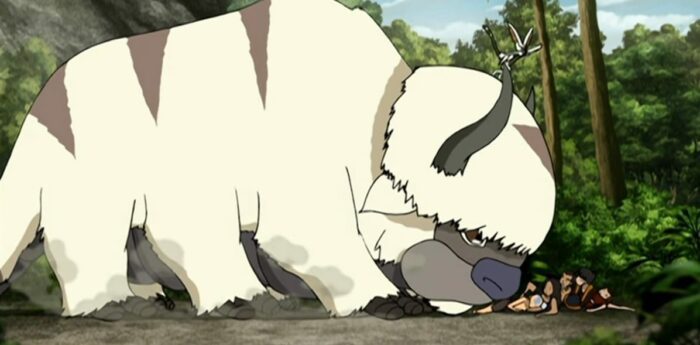
It did take me a little time to get used to the tone and style—and by “a little time,” I mean it took until about halfway through the first scene of the premiere. By the end of the first episode, I knew I’d like the show, and by the middle of the second season, I knew it would take its place among my all-time favorites. After three seasons of near perfection, it is even more than that.
Throughout the series, there are just too many things to love. All of the main characters, and many of the side characters and one-offs, are incredibly compelling. Each of the seasons builds on the previous ones. Even the silly one-off episodes (yes, even the derided and dismissed “The Great Divide”) have a depth that I can’t wait to go back to again and again. The themes of the show are well established and seeded throughout the run. The absolute capper though, the part of the show that ties the whole thing together and cements its place as one of the top series in history, is the series finale, “Sozin’s Comet.”
Establishing the Stakes
Finales are hard to get right, even when they are planned. It is just as easy to blow it entirely as it is to knock it out of the park. Even among the best finales of all time, though, the ATLA finale is special. Every moment is highlighted with a beautiful specificity, every character arc gets addressed, and it all builds upon the setups that Avatar: The Last Airbender has been laying down for three seasons. There is a beautiful symmetry in the way that creators Michael Dante DiMartino and Bryan Konietzko and head writer Aaron Ehasz tie together the characters, themes, and experiences into a masterful and riveting hour and a half of television.
A key to what makes “Sozin’s Comet” so great is that it takes the time to establish each of the characters and situations that will define the battles that are coming. Nothing is rushed, everything that has been set up over the series is allowed to play out naturally, and the characters are allowed to live and breathe in the same way that they have throughout the run of the series.
I personally love those episodes, scenes, and storylines where shows (or books, or comics) allow the characters to live out times from their regular lives. Usually, in the hectic rush to get to the climax, finales don’t include these types of scenes. But nearly all of Part 1 of the ATLA finale, “The Phoenix King,” is dedicated to just that.
The “Aang Gang,” or “Team Avatar”—Sokka has always had a lot of trouble figuring out which name is best for the team and I love him even more for it—spends the beginning of the episode hanging out and the end of it searching for Aang after he goes missing. This allows each character’s mindset, fears, and desires to be brought to the forefront so that in the later episodes, when they overcome the challenges and reunite, the catharsis is even greater. Each of the main characters enters the finale with a particular set of desires, and over the course of the first two parts of the finale, we are allowed to glimpse moments that will play out over the end game.
The Phoenix King and the Fire Lord
Fire Lord Ozai is easy to dismiss as a one-dimensional villain who is only made memorable by Mark Hamill’s masterful vocal performance. It is certainly the case that his motivations are not as clear or complicated as those of his son or his brother (who are two of the most well-developed characters ever). Ozai is of course driven by the pursuit of power and the desire to establish himself as the one who finally succeeds in turning the world into a dominion of the Fire Nation.
And yet, even for Ozai, the show has some moments intended to let us think of him not as the evil monster he is, but rather the person he could have been. At the end of Part 1 of the finale, though, he fulfills his destiny by leaning fully into his villainous nature, casting aside the title of “Fire Lord” to his daughter while he takes on the title of “The Phoenix King.” His plan—to destroy all of the Earth Kingdom (which happens to be the largest and most populous nation in the world) by fire so that he and he alone can rise from the ashes—does not allow for a tremendous amount of nuance. Of course, that plan was not actually his. It was presented during a planning meeting, almost as a joke, by his daughter, Azula.
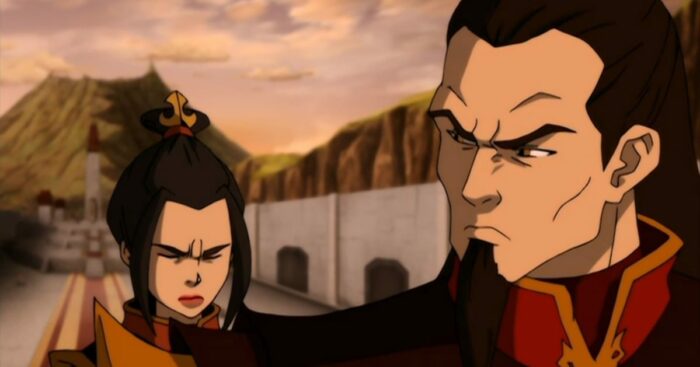
Azula, like her father, is often left off of these discussions of great characters. Sometimes it can seem that people either see her as an example of pure evil, which is absolutely not true, or that her story is truncated in favor of Zuko’s arc. I can understand how people can come to the second half of that conclusion—Zuko’s arc is a dominant and beautiful thing after all—but Azula is also much more than just a foil for her brother. Though it must be said, she is a perfect foil for Zuko and counterpart to Katara, as will become clear over the course of the finale. Throughout the series, Azula undergoes nearly as much change and loss as anyone else. The hard part is how she winds up dealing with it, and that of course is her undoing and her tragedy.
She lived her life, not in the shadow of her brother, but seeing herself in light of his failures. For example, it is established that Zuko had tremendous difficulty learning and demonstrating firebending while Azula was a prodigy. It is tempting to think of this solely in terms of how it affected Zuko, but the creators didn’t actually take that easy track. Azula’s talents are the genesis of her quest for perfection, and that quest is what ultimately makes her unstable. It is often just as difficult to live with the expectations of being exceptional as it is to deal with the guilt of feeling inadequate. Azula is also unstable and uses her considerable talent and her status as the heir to the throne of the most powerful nation in the world to try to control every aspect of the world.
By the finale, that instability has caused her to lose her control, lose her friends Mai and Ty Lee, and put her in an incredibly precarious state. She has been granted everything she wanted and initially expects to be by her father’s side as he burns the Earth Kingdom to the ground (it was her suggestion after all). When she approaches him though, he is dismissive, maybe even distrustful, of her and instead sends her back to the Fire Nation to serve as the new Fire Lord.
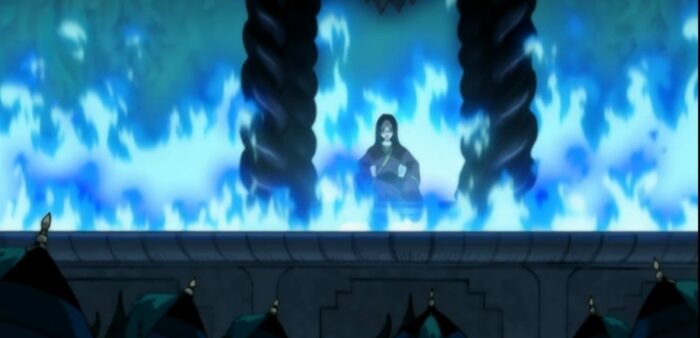
This could seem like it is a positive thing, since she had always thought the power and position was her birthright, but it isn’t. Instead, she sees it as another betrayal, another piece in a cycle; no matter how great she is, or how much like her father she acts, she will never live up to the image of herself in her mind.
We are given glimpses into the results of this disastrous break. Azula has become paranoid, distrusting, and unstable. She dismisses her maidservants after finding a single pit in cherry. She reprimands her Dai Li secret police for taking five minutes to respond to her summons—five minutes in which she insists she could have been assassinated. Azula sits on the throne of the Fire Lord, a shadow obscured by flames, unable to think or act clearly.
Grey DeLisle’s voice work is also critical to this breakdown. Up until this point, the vocal work has been impeccable and precise as Azula has been defined by her unfeeling resolve. But as the finale progresses, DeLisle delivers each line with an increasing edge. She is being torn apart from the inside and the animation and vocal performance both take the viewer on the journey.
Azula’s aloofness and dispassionate nature have always been represented by the white-hot blue fire she produces. That she manifests blue bolts instead of the orange flames of nearly every other firebender is a perfect visual encapsulation of her interior concept of life.
But in these episodes it is clear that she has changed; her flames and her life all have been driven to madness of abandonment and disarray. As she attempts to prepare for her coronation ceremony as Fire Lord, now completely alone, she slashes at her hair and condemns the world for mocking her power. And yet, each moment makes her more sympathetic and reminds the viewer that she was never given the gift her brother got: space and the opportunity to move away from the violence of their family.
Prince Zuko of the Fire Nation and Katara of the Water Tribe
Zuko, of course, had more time away than he could have ever wanted. His years in exile, searching for the Avatar and for his honor, led him to both of those things in ways he never could have found had he been at home by his father’s side as his sister had been. Zuko, though, has spent the time learning at the side of his incredibly spiritual and grounded uncle, searching and losing and gaining and losing again.
Dante Basco was always able to find the perfect balance to voicing the character as well. He is defined by his honor, sure, but also by the loving way he reacts to all of the other characters, and the nuanced performance sells every step of the journey that Zuko takes over the course of the series.
Zuko’s redemptive arc has mostly come to a close by the finale, though there are two moments of intense emotional catharsis, both for him and for the viewer, yet to come. Zuko spends these first establishing moments as the mentor, the grounding influence, and the one who the others look to for guidance. Zuko has found his honor, even if he doesn’t quite know it yet because he hasn’t forgiven himself for his past.
More than that though, he has found his family. When Zuko discovers in the opening scene that Aang and the others have decided not to fight Ozai before the comet comes because they don’t think they can win yet, his anger is righteous but his hurt is from a place that I don’t think he knew he had. It is almost as though his new family has left him out in the same way his old family had always done. Zuko alone, again.
But it turns out this is not the case. As soon as the others learn that Ozai is going to use the power of the comet to destroy the Earth Kingdom, they all quickly regroup and move to figure out how to win the war. Far from being the outcast, it is Zuko who is now central to the success of everything. He is the Avatar’s firebending master, of course, but he is also more than that. He is now fully a part of the team and even invited to the group hugs.
Once Aang disappears, it is Zuko who is most responsible for leading the others and for pushing forward. The connections between Zuko and each of the other characters are deeply felt, even though he has only been with the main characters for a few episodes.
The most amazing thing about it is that every bit of it feels earned. When Toph pushes to have her own “life-changing field trip” with Zuko, the line works because the time has been given to make it work. Although the time they spend together doesn’t work out for them in the finale, I like to imagine that they will eventually have a real adventure together in the time between the series.
![]()
Zuko’s interior life and oscillating redemptive arc are stunning to behold and incredible storytelling, but in the finale, it is the resolution of these smaller character-based moments that define who he is. The moment of truth will come in Part 3 when he finally comes face to face with the embodiment of his guilt, and we will get to that moment, but for the bulk of the finale, the most important of these interactions are between Zuko and Katara.
Katara has, throughout the series, been on her own hero’s journey. Similar to Aang’s status as the last airbender, she is the last waterbender of the southern water tribe (at least she is the last one who hasn’t succumbed to the harshness of her condition and her need for vengeance). Her decision to travel with Aang was just as motivated by her own need to find a master as it was his. While she is certainly compared to and shaped by Aang and Zuko, she remains her own character throughout the finale, making her own choices and ultimately taking down her own villains.
Katara and Zuko have been established as polar opposites, water and fire, who can come into conflict easily but also work together as an incredible force. This has of course also led to the inevitable “shipping” of the two characters as a couple. As I have noted before, I understand the impulse people have to do this. It is easy to see teamwork, chemistry, and friendship between two straight, cis-gendered male and female characters and to overlay it with a romantic and sexual veneer.
While this is easy, I don’t think it is necessary or useful for the characters. I understand this impulse much more (even though it isn’t something I personally am prone to do) when fans put ostensibly straight characters into LGBTQIA+ pairings because that is actually representative of how few canonical LGBTQIA+ relationships are actually presented in any media. Katara and Zuko are an incredible pair and a great team with undeniable chemistry, but that doesn’t make them a couple (and that will pay off incredibly well for both of them later in the finale).
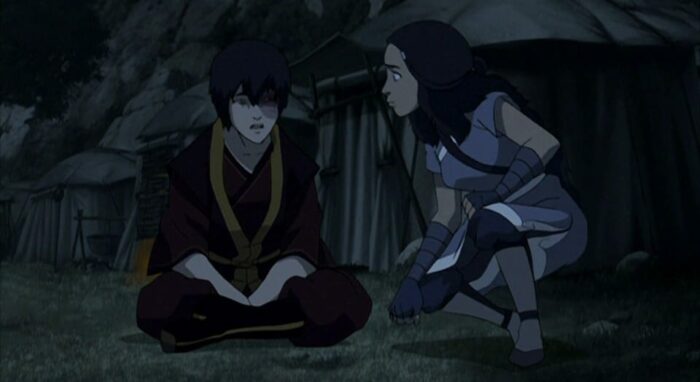
The Last Airbender
With such an amazing group of incredible characters like Zuko, Katara, Toph, Iroh, Sokka, and Appa, it is easy to forget that the kid at the center of it all is amazing, too. Aang is much more than just a collection of Joseph Campbell tropes. From his introduction, it has been clear that there are two essential motivating factors for Aang: having fun and dealing with his overwhelming guilt.
From the very moment he ran away, Aang has been wracked by guilt and feelings of inadequacy. He did not want or accept his role as the Avatar and, to him, his decision to run is what led to the Fire Nation destroying all of the Air Nomads and embroiling the world in 100 years of war. Now he is the last airbender, the only one of his people left in the world, and the pressure of that status pops up often during the series. In the finale, though, this general guilt is combined with a different sort of fear: fear that he might actually have to kill to save the world.
Aang is then doubly scared, afraid that he might not be able to beat Ozai and also afraid that he might be forced to give up his own sense of morality in order to accomplish the goal. As the last airbender in the world, he sees his place not just as the Avatar but as the standard-bearer for his people, and his people were non-violent monks, not killers. Over the course of the first two parts of the finale, Aang looks deep within himself to try to find the answers and it winds up taking him on a journey to the ends of the earth.
Aang leaves the others, frustrated by their inability to understand why killing Ozai bothers him so much, and winds up on a different type of journey than his usual ones to the spirit world. Aang and Momo wander out to a mysterious island that appears from nowhere in the bay of Ember Island. Once they are on it, the island moves, taking them far away from all the others and deep into the recesses of Aang’s subconscious mind.
Aang attempts to get advice from his former selves, but it does not work. Each of them tells him that he must give up his own ideals in the service of his duty as the Avatar. Even Yangchen, the most recent airbender Avatar before Aang, tells him that he cannot put his pacifism ahead of his duty. As the island moves farther and farther away from everything and everyone, Aang becomes more and more convinced that killing Ozai is his destiny.
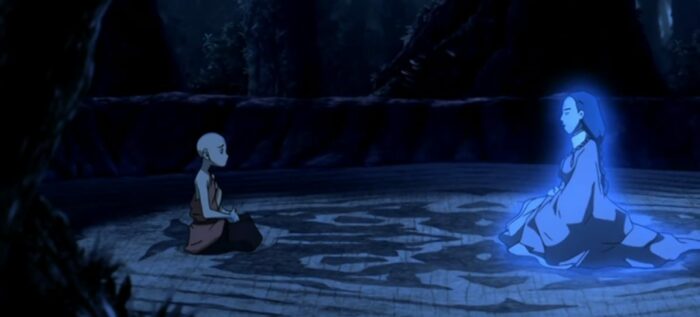
That is, until the island reveals what it truly is. This mass turns out to be a lion-turtle, the enormous beasts that are a part of the origin myths of civilization and the Avatar in the ATLA universe. The lion-turtle touches Aang’s head and opens a spark in his mind, then he releases him on the shore of a distant rocky continent. Aang has been delivered by fate to the spot where he and Ozai will battle, and he has been given the insight to, for a short time, put his fears and guilt behind him.
The Dragon of the West
Zuko has also cast almost all of his own guilt aside, except for the one thing that eats at him most of all: his betrayal of his uncle, Iroh. Iroh had been his mentor, his teacher, and his father figure, but at the end of Season 2, Zuko cast all of that aside to rejoin his sister at the hand of his father. Zuko feels deeply that there is no way Iroh can ever forgive him, and his guilt has kept him from trying to contact his uncle after they both escaped their prisons.
However, once it becomes clear that the group will not find Aang, Zuko knows their only chance to win the war is with Iroh. So Zuko, Katara, Toph, Sokka, Suki, and Appa search for “the Dragon of the West” and ultimately find him outside the walls of Ba Sing Se.
Iroh has spent the season quietly preparing, getting in shape, breaking out of prison, and calling upon his friends in the Order of the White Lotus. The reasons for this are two-fold. In the world of Avatar: The Last Airbender, it reflects Iroh’s determination and his very real sense of betrayal by Zuko. The biggest reason, though, is probably that the creative team had to recast Iroh’s voice actor between the second and third seasons.
Iroh had been voiced by the legendary Japanese actor and singer Mako. Mako’s work with the character is impeccable and untouchable. Every word and phrase feels authentic because it is being delivered by a master who basically channels the spirit of Iroh. It is nearly impossible to even think of the song he sings in “The Tales of Ba Sing Se” without tearing up, much less to actually watch and listen to it. After Mako’s death, the role was taken over by Greg Baldwin. Baldwin does an admirable job with the role, respecting the primacy of Mako’s performance and still giving the character his own spin. But it is clearly not the same experience and so the greatly reduced number of lines is understandable.
Once they get to Iroh’s camp, Zuko goes to apologize to his uncle, unsure of what he can say or how Iroh will react. In a sweetly perfect scene, Zuko enters Iroh’s tent while the old man is asleep. Rather than waking him or walking away, Zuko sits down and waits. The quiet respect and admiration are somehow palpable even on Zuko’s static, animated face. When Iroh does finally wake up, he grabs his nephew and hugs him tight. Tears stream down his face as he says that he was never angry, just afraid Zuko had lost his way. And with those tears and that hug, there is a cathartic release.
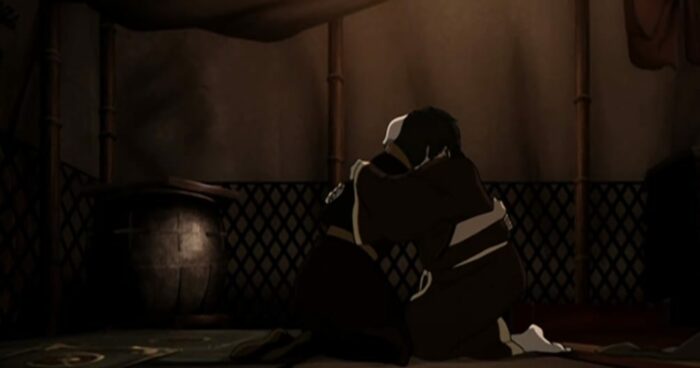
The Old Masters
With Zuko and Iroh finally reconciled, the stage is set for the endgame. In one part of the final battle, The Order of the White Lotus, led by General Iroh at the height of his enormous power, takes back Ba Sing Se for the Earth Kingdom. Iroh fulfills his own prophetic dreams of conquering the city, but he does it not as an invader but as a liberator. Iroh is assisted by “The Old Masters” who have all had some major impact on the story and characters, but this fight is at its heart one that is about Iroh and his grief.
The kindly, tea-loving, would-be Fire Lord is the person who has fostered much of the love and wisdom that will win the war, and Ba Sing Se was the place where he nearly lost everything. Iroh spent 400 days on a failed siege of the city, ruining his military career. Ba Sing Se was the site where his son was killed, and finally it was the place where Zuko betrayed him. The “city of walls and secrets” has been for Iroh a place of enormous pain, and so having the city be the place of Iroh’s triumph is well and truly earned.
The second part of the final battle takes place on Ozai’s airships where Sokka, Suki, and Toph try to hold off the destruction until Aang shows up. Within this battle, Sokka displays his trademark creativity and ability to bounce back from hardships (like his trusty boomerang). Suki winds up windsurfing on an airship. Toph basically takes out the entire fleet with her toughness and metalbending skill.
In a finale filled with epic showdowns that have been running throughout the series like Iroh’s conquest of Ba Sing Se, the last Agni Kai between Azula and Zuko, and the showdown between the series’ main protagonist and antagonist, their situation could have seemed like a sideshow, secondary and unimportant. The fact that it instead gives us one last chance to revel in the ingenuity of these characters is just one more way in which Avatar: The Last Airbender exceeds even its own lofty standards.
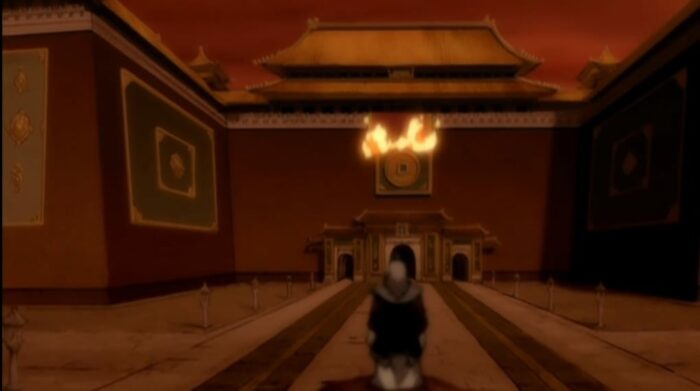
The Last Agni Kai
Zuko and Katara have a different mission, though. They arrive back in the Fire Nation for the final confrontation between Zuko and Azula. All three of them have a history, both with each other and with the very nature of how they fit into the world, and in these few incredible scenes, they each seem to have developed and deepened more than most shows allow their characters over the entire series. All of the character arcs and moments that we discussed earlier are brought to the forefront in this feverish and vivid collection of scenes.
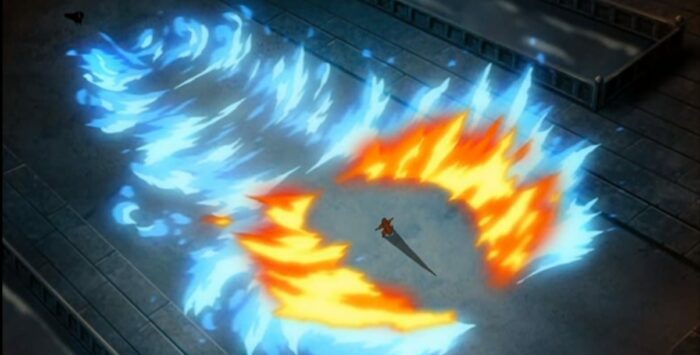
Zuko and Katara arrive at the Fire Nation capital just as Azula is about to be officially crowned as the new Fire Lord (I believe that, much like the Queen of the United Kingdom, she was already the Fire Lord upon pronouncement from her father and that the ceremony is just the culmination, but that is an argument for another day). Rather than launching a full attack, Zuko challenges his sister to an Agni Kai. What follows is one of the great scenes of the Avatar: The Last Airbender series finale, and possibly all of television history.
Zuko and Azula are contrasted, not just in their personalities, but also in their visual presentation. “The last Agni Kai” is a series of scenes that have some of the most gorgeous animation and cinematography in the series’ run. Azula’s cold-looking blue flames fill the screen only to be met by the red hot fire of Zuko. As the duel’s intensity grows, so does the vivid quality of the colors and the intensity of the camera work. The camera flows around the scene, using the medium of animation to get the very most out of each emotionally resonant and beautiful moment.
By not being bound by the constraints of real cameras and actors, the camera perspective changes about 30 times during the battle. From Zuko’s perspective, from Azula’s, from above, traveling along the paths of the firebolts as they propel toward their targets and so much more. The colors grow ever more vivid and the intensity levels up with each blast. The score by Jeremy Zuckerman is a gorgeous mournful wash that matches each step the combatants take. The music and light fill the screen as if they are going to jump off of it, until Katara steps onto the dueling field.
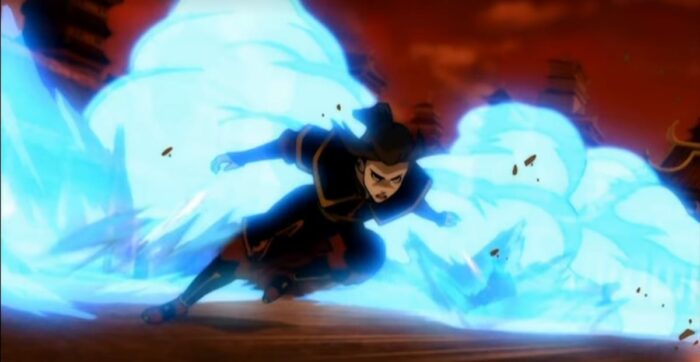
Zuko then reaches his final moment of destiny. Azula decides to break the rules of the Agni Kai and shoot her lightning blast at Katara. Zuko jumps in front of the blast, which he is able to redirect using Iroh’s method of directing lightning like water. This is a confluence: Zuko is emulating his uncle, using the skills of waterbending to preserve the last waterbender of the southern water tribe, and putting his life on the line for the life of his friend.
The amazing thing is that Zuko, unlike some other similar characters who will not be named from other properties, isn’t doing this because of some sort of romantic love (again, sorry Zutara shippers, I do get why you think it). Zuko is making the “sacrifice play” here entirely because as he looks at what is happening, he knows that it is the only way he can preserve everything he has worked for.
It is at this moment that Katara becomes the focal point of the scene. Zuko is sidelined, but the duel continues. Katara and Azula are perhaps even more perfectly matched than the siblings had been. The two women, more so than Zuko or even Aang, are the prodigies of their bending disciplines (although Toph Beifong, who may be the most skilled earthbender ever, could probably wipe the deck with both of them). The battle continues as an equal match—blue flames meeting blue water, hot fire and cold ice colliding in midair—as the two combatants pour their powers out on the field.
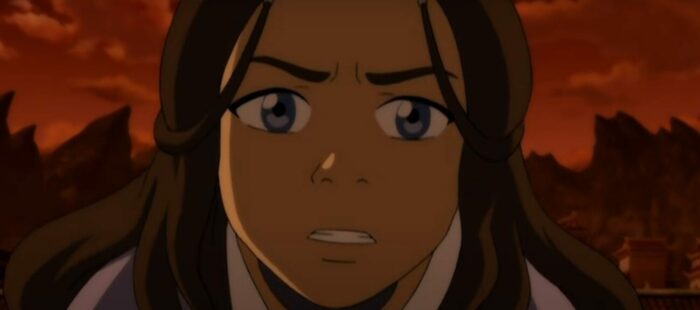
Katara is the one who eventually ends “the last Agni Kai” (and the short reign of Fire Lord Azula) by using her entire set of skills. While the two foes are basically easily matched in bending talent, Katara is far more adept than this confused and mentally broken version of Azula. Katara leads Azula beneath a support structure that has a water pipe running beneath it and uses her incredible skill and control to freeze the water around Azula, trapping her and chaining her so that she can no longer fight. This is the last scene of Azula, sputtering and breathing fire, completely torn apart, and it is heartbreaking.
The Final Battle
While “the last Agni Kai” is occurring deep within the Fire Nation, it is in the desert lands on the edge of the Earth Nation the final battle between the Avatar and the Phoenix King comes to pass. Aang and Ozai do battle, both in a mountainous desert and within Aang’s body and spirit. The battle is long and harsh, with Aang mostly on the defensive, unwilling or unable to take the upper hand. He is locked in, his chi blocked, and his anguish at the idea of possibly having to kill Ozai is keeping him from being able to do the deed.
And then everything changes. An attack from Ozai smashes Aang against a rock and the impact releases the chi blocking him from the Avatar state. But more is released for Aang than just his ability to access the Avatar form. While this does mean that he is able to fully access his power for the first time since he was nearly killed by Azula, it also allows him to be fully open with himself. He can access both his past selves and his internal needs more fully than ever before. The power gives him a decided advantage in the fight. Avatar Aang is a wonder, pulling all of the elements into his orbit and immediately taking absolute control over the battle.
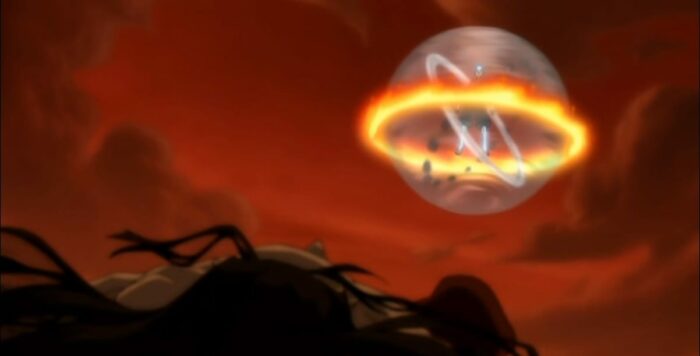
It is quickly clear that Ozai is no match for the Avatar, and the Avatar will do what it takes to end this war. As the Avatar bears down on the foe with all its might and the booming voice calls out the punishment for all of Ozai’s sins, it becomes clear that the Avatar is going to kill the Phoenix King. But Aang the peaceful monk, the last airbender, is able to push through even the power of the Avatar. It is the person Aang, the singular hero of this particular story, with all his love and silliness and need to avoid killing, that spares the life of the villain.
Aang is unwilling to kill his enemy, but the lion-turtle has given him the power to destroy Ozai just as thoroughly. He has been given the power to overcome the innate energy of his opponent, and in the process take away the person’s ability to bend the elements. The image of this moment is iconic and infused with great symbolic resonance.
Aang and Ozai are in the center of the frame—Ozai bound in a kneeling position, Aang with his hand on the other’s head. Their mouths and eyes open and expel a flood of energy, white for Aang and red for Ozai. The energy flows from them in a visual flood of light. Finally, Aang’s white light overwhelms Ozai’s fire and it is done. Aang stumbles to the ground as Toph, Sokka, Suki, and Momo return to him. The war is won.
The Aftermath
Great stories linger both in our minds and in our hearts. The final scenes of “Part 4: Avatar Aang” are the calm that follows the epic story and each of the scenes is essential and allows for the feelings to flow. It is a series of wonderful scenes capped by tiny moments.
Zuko is crowned as the new Fire Lord, with Aang at his side. The capper is Zuko’s slight head nod and wink at Aang as they stand together, united, with all of the people gathered in front of them representing the nations reunited. They spend this moment promising to remake the world and make it better.
In the last scene, all of the core characters are reunited back at Iroh’s tea shop in Ba Sing Se. They engage in some banter: Iroh laughing about his weight, everyone once again making fun of Sokka’s lack of artistic skill, Toph laying trademark snark on everyone. In the midst of the revelry, Aang wanders outside giving Appa a pat on the head as he leaves. Appa snorts and stares. Aang is alone and seems to be thinking that he may always be alone when Katara comes out and takes his hand. The series ends with the two of them kissing as the viewers look over the city of Ba Sing Se and out into the setting sun, capping the perfection of the entire series in a moment of intimate tenderness.
